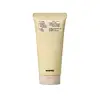What's inside
What's inside
 Key Ingredients
Key Ingredients

 Benefits
Benefits

 Concerns
Concerns

 Ingredients Side-by-side
Ingredients Side-by-side

Glycerin
HumectantSodium Cocoyl Isethionate
CleansingWater
Skin ConditioningCoconut Acid
CleansingNiacinamide
SmoothingCetearyl Alcohol
Emollient1,2-Hexanediol
Skin ConditioningCoco-Betaine
CleansingPersea Gratissima Oil
Skin ConditioningMyristic Acid
CleansingSodium Isethionate
CleansingStearic Acid
CleansingVanilla Planifolia Fruit Extract
Skin ConditioningCentella Asiatica Extract
CleansingSodium Hyaluronate
HumectantCeramide NP
Skin ConditioningSaccharide Hydrolysate
HumectantGardenia Florida Fruit Extract
Skin ConditioningPropylene Glycol
HumectantButylene Glycol
HumectantPolyquaternium-67
Sodium Acetate
BufferingDextrin
AbsorbentHydrogenated Lecithin
EmulsifyingPalmitic Acid
EmollientSodium Chloride
MaskingCitrus Limon Peel Oil
MaskingCitrus Aurantifolia Oil
CleansingCitrus Paradisi Peel Oil
MaskingLimonene
PerfumingCitral
PerfumingGlycerin, Sodium Cocoyl Isethionate, Water, Coconut Acid, Niacinamide, Cetearyl Alcohol, 1,2-Hexanediol, Coco-Betaine, Persea Gratissima Oil, Myristic Acid, Sodium Isethionate, Stearic Acid, Vanilla Planifolia Fruit Extract, Centella Asiatica Extract, Sodium Hyaluronate, Ceramide NP, Saccharide Hydrolysate, Gardenia Florida Fruit Extract, Propylene Glycol, Butylene Glycol, Polyquaternium-67, Sodium Acetate, Dextrin, Hydrogenated Lecithin, Palmitic Acid, Sodium Chloride, Citrus Limon Peel Oil, Citrus Aurantifolia Oil, Citrus Paradisi Peel Oil, Limonene, Citral
Water
Skin ConditioningStearic Acid
CleansingPEG-8
HumectantMyristic Acid
CleansingPotassium Hydroxide
BufferingGlycerin
HumectantLauric Acid
CleansingAlcohol
AntimicrobialButylene Glycol
HumectantGlyceryl Stearate Se
EmulsifyingPolyquaternium-7
Parfum
MaskingDisodium EDTA
Sodium Benzoate
MaskingSodium Metabisulfite
AntioxidantSodium Hyaluronate
HumectantSericin
Skin ConditioningSodium Acetylated Hyaluronate
HumectantCitric Acid
BufferingPotassium Sorbate
PreservativeHydrolyzed Silk
HumectantWater, Stearic Acid, PEG-8, Myristic Acid, Potassium Hydroxide, Glycerin, Lauric Acid, Alcohol, Butylene Glycol, Glyceryl Stearate Se, Polyquaternium-7, Parfum, Disodium EDTA, Sodium Benzoate, Sodium Metabisulfite, Sodium Hyaluronate, Sericin, Sodium Acetylated Hyaluronate, Citric Acid, Potassium Sorbate, Hydrolyzed Silk
 Reviews
Reviews

Ingredients Explained
These ingredients are found in both products.
Ingredients higher up in an ingredient list are typically present in a larger amount.
Butylene Glycol (or BG) is used within cosmetic products for a few different reasons:
Overall, Butylene Glycol is a safe and well-rounded ingredient that works well with other ingredients.
Though this ingredient works well with most skin types, some people with sensitive skin may experience a reaction such as allergic rashes, closed comedones, or itchiness.
Learn more about Butylene GlycolGlycerin is already naturally found in your skin. It helps moisturize and protect your skin.
A study from 2016 found glycerin to be more effective as a humectant than AHAs and hyaluronic acid.
As a humectant, it helps the skin stay hydrated by pulling moisture to your skin. The low molecular weight of glycerin allows it to pull moisture into the deeper layers of your skin.
Hydrated skin improves your skin barrier; Your skin barrier helps protect against irritants and bacteria.
Glycerin has also been found to have antimicrobial and antiviral properties. Due to these properties, glycerin is often used in wound and burn treatments.
In cosmetics, glycerin is usually derived from plants such as soybean or palm. However, it can also be sourced from animals, such as tallow or animal fat.
This ingredient is organic, colorless, odorless, and non-toxic.
Glycerin is the name for this ingredient in American English. British English uses Glycerol/Glycerine.
Learn more about GlycerinMyristic Acid is a saturated fatty acid. It is naturally found in milk fat. Other sources include palm oil, coconut oil, and butter fat.
Myristic Acid is an emulsifer and cleanser. As an emulsifer, it stabilizes a product by preventing ingredients from separating. Myristic Acid helps clean your skin by acting as a surfactant. It tends to gather oil and dirt on your skin to be easily rinsed away.
One study from 2021 found Myristic Acid to have anti-inflammatory properties.
Learn more about Myristic AcidSodium Hyaluronate is hyaluronic acid's salt form. It is commonly derived from the sodium salt of hyaluronic acid.
Like hyaluronic acid, it is great at holding water and acts as a humectant. This makes it a great skin hydrating ingredient.
Sodium Hyaluronate is naturally occurring in our bodies and is mostly found in eye fluid and joints.
These are some other common types of Hyaluronic Acid:
Learn more about Sodium HyaluronateStearic Acid is a fatty acid. It is an emollient, emulsifier, and texture enhancer.
As an emollient, stearic acid helps soften skin. It aids the skin's protective barrier by preventing water loss. It also provides a gentle cleansing effect without stripping away natural oils.
Stearic acid may also be used to enhance the texture of products. It can add volume and stabilize ingredients such as water and oil. This can help water and oil ingredients from separating.
Sources of stearic acid include animal or vegetable fats/oils such as coconut or shea. It can be naturally found in butter, cocoa butter, shea butter, vegetable fats, and animal tallow.
This ingredient may not be Malassezia folliculitis, or fungal-acne safe.
Learn more about Stearic AcidWater. It's the most common cosmetic ingredient of all. You'll usually see it at the top of ingredient lists, meaning that it makes up the largest part of the product.
So why is it so popular? Water most often acts as a solvent - this means that it helps dissolve other ingredients into the formulation.
You'll also recognize water as that liquid we all need to stay alive. If you see this, drink a glass of water. Stay hydrated!
Learn more about Water